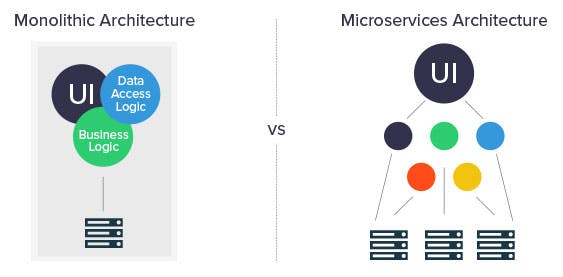In the software industry, there are various architectures that are used to develop and implement a project. Two of those architectures are the traditional monolithic architecture and microservices architecture. Let’s discuss these architectures in detail further.
Monolithic Architecture:
What is Monolithic Architecture?
As a single large application, monolithic architecture can deploy all the services and components at once. It is also known as a tightly-coupled architecture since all its components are interconnected and interdependent. Here, each component and its associated component is involved to execute code.
The small and simple businesses or applications find monolithic architecture perfect for all their activities. Some of the companies that have used monolithic architecture (before switching to microservices) include Amazon, eBay, PayPal, Netflix, Twitter, etc.
Limitations of Monolithic Architecture:
1. Takes time to start the containers: As a large application, monolithic architecture takes an enormous amount of time for the containers to start, thereby causing delays to all the stakeholders.
2. Continuous deployments take a longer time: If a single component has to be updated, the whole application has to be deployed. It may cause a problem where the components, that are not properly updated, may not start correctly. Hence, the risks involved with the redeployment might surge, which may not be favorable for frequent deployments.
3. Difficulty in scaling the application: The resource requirements for different components can vary between CPU load, memory utilization, etc. Since each component cannot be individually scaled up in the monolithic architecture, it is required to scale the entire function, which may not always be a favorable situation.
4. Developing more components within a single performing application becomes challenging: Creating components, such as search & browse, cart & checkout services, etc., would be a challenge since the developers of all the components would need to be coordinated.
5. Development needs to be re-written every time: It’s difficult to make minor edits in the technology stack, framework, etc. since the developments have to be rewritten to implement these changes.
With all these concerns under the hood, the complete software development lifecycle consumes more time and enormous efforts in the monolithic architecture. This has brought about a novel architecture structure called the microservices architecture.

Microservices Architecture:
What is Microservices Architecture?
Microservices is a systematic approach to software development lifecycle (SDLC) where software constitutes of compact independent services that communicate with each other over properly defined application programming interfaces (APIs).
Since all the components in this architecture are loosely coupled, microservices architecture is quite modular in its usability. It helps in building an application as a collection of small services, with each being independently developable and deployable. The respective services can be easily developed in multiple languages and used in multiple frameworks.
This architecture is an evolutionary plan and is apt in the areas where we cannot foresee what devices are going to access the application.
Advantages of Microservices:
1. Easier to deploy: Each service or component can be deployed independently without affecting other services or components.
2. Decentralized component development: The Microservices archetype provides the development teams with a more decentralized approach in software development.
3. Easier to interpret: As the services are independent, all the codes are easy to understand.
4. Quicker troubleshooting: Defects can be easily traced and fixed as each service has its own code.
5. Lesser risks of changes: Since the code is not complex even while containing multiple components, the changes can be easily implemented without any fear of dependencies on other components.
6. Mixed technologies: New technologies can be implemented by the developers without committing to the older technology stack.
7. Easy to scale: Microservices architecture is easily scalable and can be integrated with third-party services - courtesy, the independence of the services.
8. More reactive to the customer’s requirements: The teams can be more responsive to the customer’s needs and quickly provide solutions without having to stick to a fixed schedule.
9. Continuous delivery: If the application demands continuous changes, microservices will fit in very well to deploy and deliver the constant changes.
10. Security: The microservices architecture pacifies various security concerns that otherwise created obstacles in the Monolithic architecture. Security monitoring is easier since multiple services can be monitored separately.
Understanding both the architectures, it’s easier to gauge what compelled the stakeholders to switch to microservices against the monolithic. Thus, the current software industry is widely inclined towards implementing microservices in their software development lifecycle.



